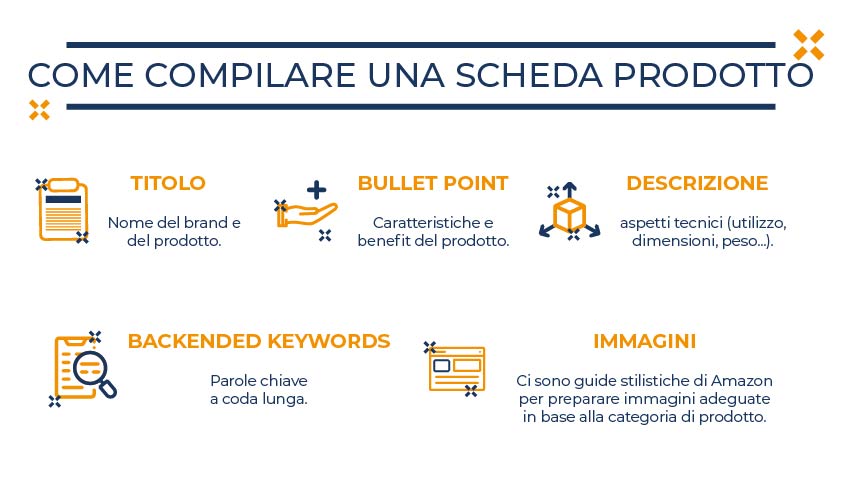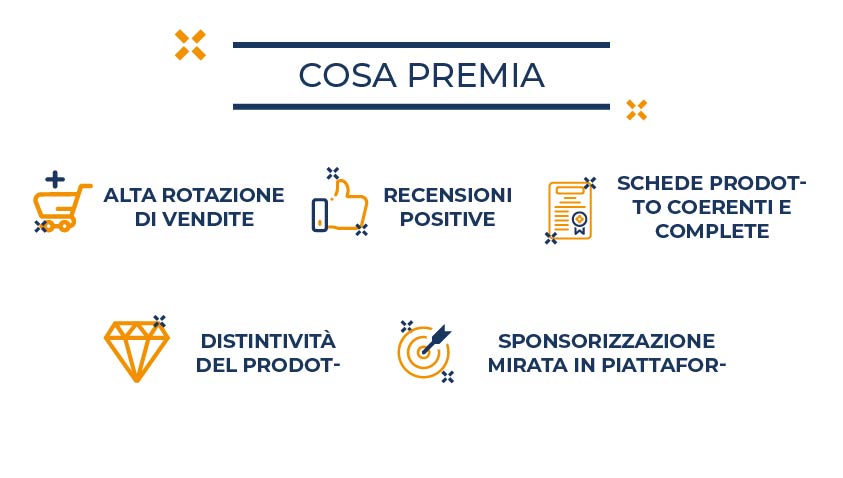- optimized creation of product pages (images and text)
- importance of SEO optimization, as a key to achieving a natural rise of products in the first search pages
As we have mentioned several times, presence on Amazon is now a must for any company that wants to keep up with the times and win new consumers online. To achieve our goals in terms of visibility and sales, however, consumers must find us. Today, therefore, we will focus on how we can create an optimized profile that can appear among the top search results, a key factor in not being cannibalized by competitors.
First of all, it is good to preface this with the fact that Amazon’s terms of service can be very stringent, and filling out product sheets that do not adhere to its rules can result in:
- removal of the product from the Amazon catalog
- suspension of the seller’s account
- the possibility of being permanently banned from the marketplace.
For these reasons, complying with the terms of service and proceeding to compile consistent product sheets is vital not only for sales but for the presence on Amazon itself.
After this necessary introduction, let’s talk about how Amazon search works, which is exactly like Google search: the user types in a keyword that will result in a landing page. Most users inclined to purchase search for products directly on Amazon without the intermediation of Google. As a result, ranking your products high in search means a higher chance of return on sales. Let’s see how to achieve this.
Amazon, unlike Google, is a closed and preset environment with its own rules, and it is important to start by understanding its dynamics to write titles and product descriptions that can really have an impact on sales.
Amazon’s algorithm rewards sales-related aspects such as, for example, reviews and number of conversions, placing products that have a better sales performance in the top positions with clear and explanatory content for the purpose of purchase.
As for descriptions, it will be necessary to determine the most relevant keywords concerning our product through a search of the words most searched by users on the platform, and then use them strategically in the following items:
- Title: where to enter the name of the brand and product without any qualitative description, which, by policy, is not allowed at this stage.
- Bullet Point: In this space, it is advisable to describe the features of the product, but also the benefits. A complete description that can give the consumer all the information they are looking for is rewarded by Amazon.
- Description: where to delve into the more technical aspects (use, size, weight…).
- Backend Keywords: It is possible to insert some long-tail keywords that are not visible to the user but only to Amazon’s algorithm.
- Images: images must respect some rules in order to allow users to see every detail of the product. There are real Amazon-style guides that explain how to prepare appropriate images according to the product category. Generally speaking, we can say that the main image should be in color on a pure white background, in line with the background of the product pages, and should optimally show the product without the presence of third-party elements (graphics or additional objects) to avoid creating confusion with respect to what is offered. In addition to the main one, then, Amazon gives the option of including up to 8 images that tell the story of use or show specific details. For these additional images, the requirements are less restrictive, giving, therefore, the possibility to be more creative in displaying the product.

The rule that applies to all the above points is definitely to avoid repetition: bullet points and descriptions, for example, are two spaces with different purposes, and both should be used correctly. The ultimate goal is to provide the user with all the necessary information clearly and fluidly.
A company that is approaching the marketplace for the first time will not be able to count on the positive effect of sales and reviews and will, consequently, have to work very well on the optimization of product pages, choose products that have a distinctive value (technical or even price) compared to the competition helping them with a good sponsorship strategy.
Let’s also keep in mind that if the same product is sold by multiple sellers, the product sheet will be unique and Amazon will choose the one that is most in line with the guidelines, based on the opportunity to improve end-customer enjoyment. It may happen, therefore, to see a different tab associated with one’s product than the one compiled. The only way to remedy this problem is to declare ownership of the product by registering the trademark, but even then, there is no guarantee that the cards will remain unchanged. Certainly, the more complete and comprehensive the tabs are, the more likely it is that Amazon will validate them.
 Another very important point to emphasize is the need, if Amazon’s profile and proprietary E-commerce coexist, to differentiate product descriptions. When a user searches Google for keywords related to a product, Google always gives priority to Amazon, and this overlap would, therefore, risk damaging the positioning of e-commerce. No to “copy and paste,” then, yes to dedicated and personalized texts concerning the reference channel.
Another very important point to emphasize is the need, if Amazon’s profile and proprietary E-commerce coexist, to differentiate product descriptions. When a user searches Google for keywords related to a product, Google always gives priority to Amazon, and this overlap would, therefore, risk damaging the positioning of e-commerce. No to “copy and paste,” then, yes to dedicated and personalized texts concerning the reference channel.
Roberto Botto.
Ceo of Inthezon, a company of Libera Brand Building Group
Note: The contents of the column are the result of independent evaluations of Inthezon and not of Amazon or brands related to it.
